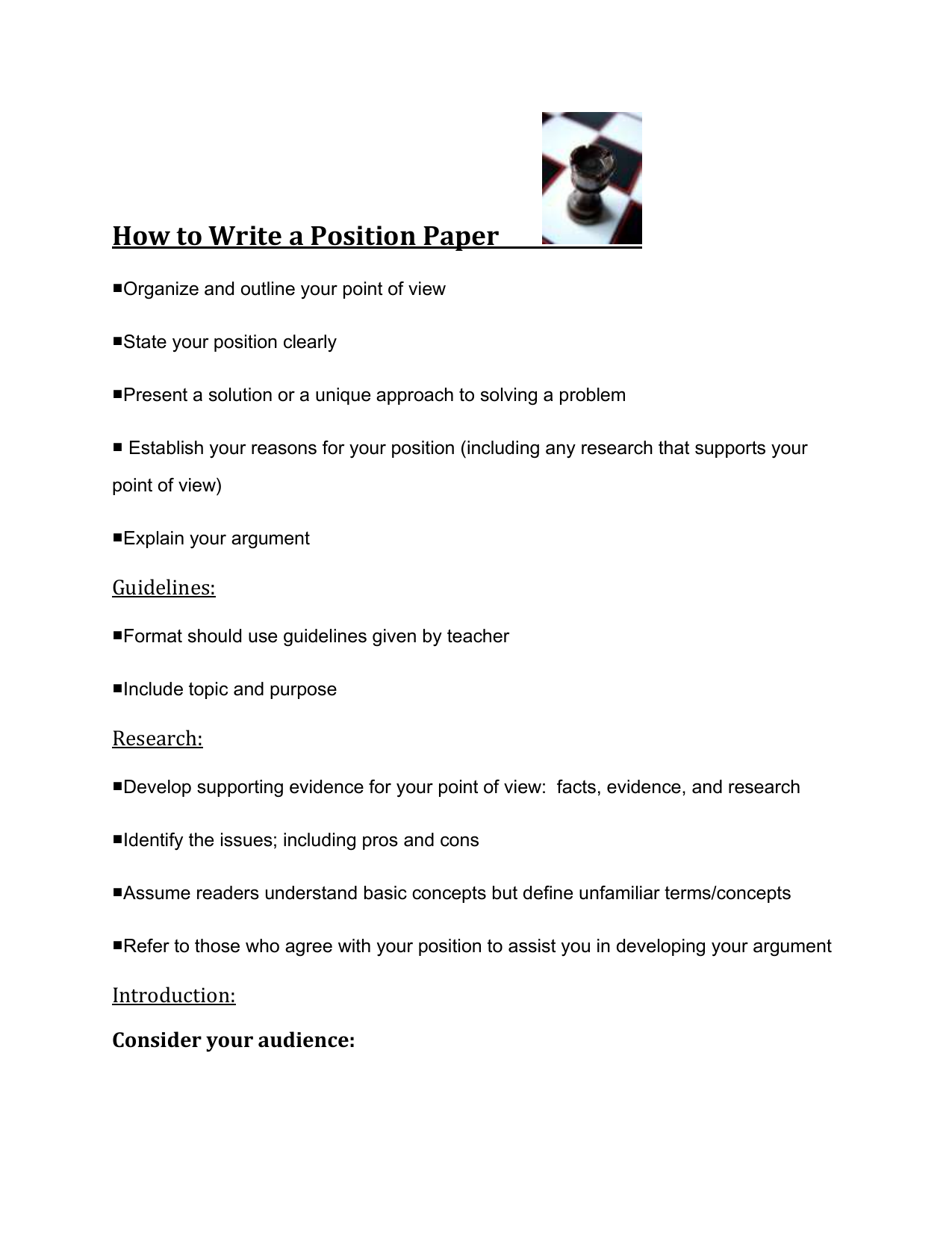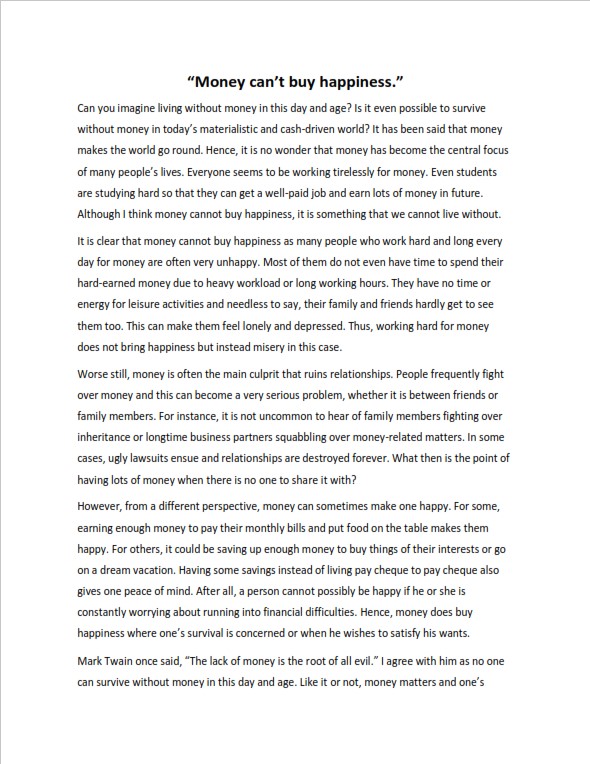
7/13/ · To start writing a position paper, you should have a clearly stated topic that is debatable with logical details. While writing a paper, you should examine your vision of the problem through the prism of available arguments. Consider practicability, cost-effectiveness, and local environment when evaluating possible solutions and necessary actions Writing a Position Paper A position paper presents an arguable opinion about an issue. The goal of a position paper is to convince the audience that your opinion is valid and worth listening to. Ideas that you are considering need to be carefully examined in choosing a topic, developing your argument, and organizing your paper position paper you should: • Use evidence to support your position, such as statistical evidence or dates and events. • Validate your position with authoritative references or primary source quotations. • Examine the strengths and weaknesses of your position. • Evaluate possible solutions and suggest courses of action
How to Write a Position Paper | Full Guide by HandMadeWriting
WRITING A POSITION PAPER, writing a position paper. The following material explains how to produce a position paper sometimes called a point of view paper. A template is provided that outlines the major parts of a good position paper. Keep in mind, however, that this is just a guide.
Talk to your TAs about their individual expectations. Your TAs may want you to include some criteria that do not appear in this outline. Make sure you check with them. Like a debate, a position paper presents one side of an arguable opinion about an issue.
The goal of a position paper is to convince the audience that your opinion is valid and defensible. Ideas that you are considering need to be carefully examined in choosing a topic, developing your argument, and organizing your paper. It is very important to ensure that you are addressing all sides of the issue and presenting it in a manner that is easy for your audience to understand.
Your job is to take one side of the argument and persuade your audience that you have well-founded knowledge of the topic being presented. It is important to support your argument with evidence to ensure the validity of your claims, as well as to refute the counterclaims to show that you are well informed about both sides.
To take a side on a subject, you should first establish the arguability of a topic that interests you. Ask yourself the following questions to ensure that you will be able to present a strong argument:. In the CMNS courseware writing a position paper article by Fleras begins to set out a range of issues you may choose to address. Your tutorial leader writing a position paper also have a set of suggested paper topics.
The suggested paper topics will also be available on the CMNS website. Once your topic is selected, you should do some research on the subject matter. While you may already have an opinion on your topic and an idea about which side of the argument you want to take, you need to ensure that your position is well supported. Listing the pro and con sides of the topic will help you examine your ability to support your counterclaims, along with a list of supporting evidence for both sides.
Supporting evidence includes the following:. How to find these sources. introductory information and overviews. writing a position paper, encyclopedias, handbooks. Use the Library catalogue, writing a position paper. in-depth studies. books, government reports. Library catalogue, Canadian Research Index, Government web sites.
scholarly articles. academic journals. Article indexes. current issues. newspapers, magazines. government agencies and associations, writing a position paper. Statistics Canada, writing a position paper, Canadian Research Index, journal articles. position papers and analyses.
association and institute reports. Library catalogue, web sites. Many of these sources can be located online through the library catalogue and electronic databases, or on the Web. You may be able to retrieve the actual information electronically or you may have to visit a library to find the information in print.
This is simply a list of the various options available to you. Consult your separate assignment sheet to clarify the number and type of sources expected.
Once you have made your pro and con lists, compare the information side by side. Considering your audience, as well as your own viewpoint, choose the position you will take. Considering your audience does not mean playing up to the professor or the TA. To convince a particular person that your own views are sound, you have to consider his or her way of thinking.
You will have to make specific decisions about the terms you should explain, the background information you should supply, and the details you need to convince that particular reader. Assert the thesis your view of the issue. More on thesis statements can be found below. One effective way of introducing a topic is to place it in context — to supply a kind of backdrop that will put it in perspective.
You should discuss the area into which your topic fits, and then gradually lead into your specific field of discussion re: your thesis statement. Give evidence for argument. You can generate counterarguments by asking yourself what someone who disagrees with writing a position paper might say about each of the points you've made or about your position as a whole.
Once you have thought up some counterarguments, consider how you will respond to them--will you concede that your opponent has a point but explain why your audience should nonetheless accept your argument? Will you reject the counterargument and explain why it is mistaken? Either way, you will want to leave your reader with a sense that your argument is stronger than opposing arguments. When you are summarizing opposing arguments, be charitable.
Present each argument fairly and objectively, rather than trying to make it look foolish. You want to show that you have seriously considered the many sides of the issue, and that you are not simply attacking or mocking your opponents.
It is usually better to consider one or two serious counterarguments in some depth, rather than to give a long but superficial list of many different counterarguments and replies. Be sure that your reply is consistent with your original argument. If considering a counterargument changes your position, you will need to go back and revise your original argument accordingly.
You may have more than 3 overall points to your argument, writing a position paper, but you should not have fewer. Provide a plan of action but do not introduce new information.
The simplest and most basic conclusion is one that restates the thesis in different words and then discusses its implications. Writing a position paper thesis is a one- sentence statement about your topic. It's an assertion about your topic, something you claim to be true. Notice that a topic alone makes no such claim; it merely defines an area to be covered. To make your topic into a thesis statementyou need to make a claim about it, make it into a sentence.
Look back over your materials--brainstorms, investigative notes, etc. Think about what your readers want or need to know, writing a position paper. Then write a sentence, preferably at this point, a simple one, stating what will be the central idea of your paper. The result should look something like this:. Original Subject: an important issue in my major field. Focused Topic: media technology education for communication majors.
Thesis: Communication majors at this University receive a solid background in theories of writing a position paper technology. Notice, though, that a sentence stating an obvious and indisputable truth won't work as a thesis:. That's a complete sentence, and it asserts something to be true, but as a thesis it's a dead end, writing a position paper.
It's a statement of fact, pure and simple, and requires little or nothing added. A good thesis asks to have more said about it. It demands some proof. Your job is to show your reader that your thesis is true. Remember, writing a position paper, you can't just pluck a thesis out of thin air.
Even if you have remarkable insight concerning a topic, it won't be worth much unless you can logically and persuasively support it in the body of your essay. A thesis is the evolutionary result of a thinking process, not a miraculous creation. Formulating a thesis is not the first thing you do after reading the essay assignment.
Deciding on a thesis does not come first. Before you can come up with an argument on any topic, you have to collect and organize evidence, look for possible relationships between known facts such as surprising contrasts or similaritieswriting a position paper, and think about the beneath-the-surface significance of these relationships.
After this initial exploration of the question at hand, you can formulate a "working thesis," an argument that you think will make sense of the evidence but that may need adjustment along the way. Many students make the mistake of thinking that writing a position paper content of their paper is all that matters. You may have some great ideas in your paper but if you cannot effectively communicate them, you will not receive a very good mark. Keep the following in mind when writing your paper:.
Writing a position paper refers to the choice of words for the expression of ideas; the construction, disposition, and application of words in your essay, with regard to clearness, accuracy, variety, etc. There is often a tendency for students to use fancy words and extravagant images in hopes that it will make them sound more intelligent when in fact the result is a confusing mess.
Although this approach can writing a position paper be effective, it is advisable that you choose clear words and be as precise in the expression of your ideas as possible. Creating clear paragraphs is essential. Paragraphs come in so many sizes and patterns that no single formula could possibly cover them all.
The two basic principles to remember are these:.
4 - Writing position paper
, time: 3:16Top 10 Tips For Writing a Strong Position Paper - Enago Academy

7/13/ · To start writing a position paper, you should have a clearly stated topic that is debatable with logical details. While writing a paper, you should examine your vision of the problem through the prism of available arguments. Consider practicability, cost-effectiveness, and local environment when evaluating possible solutions and necessary actions Writing a Position Paper A position paper presents an arguable opinion about an issue. The goal of a position paper is to convince the audience that your opinion is valid and worth listening to. Ideas that you are considering need to be carefully examined in choosing a topic, developing your argument, and organizing your paper position paper you should: • Use evidence to support your position, such as statistical evidence or dates and events. • Validate your position with authoritative references or primary source quotations. • Examine the strengths and weaknesses of your position. • Evaluate possible solutions and suggest courses of action

No comments:
Post a Comment